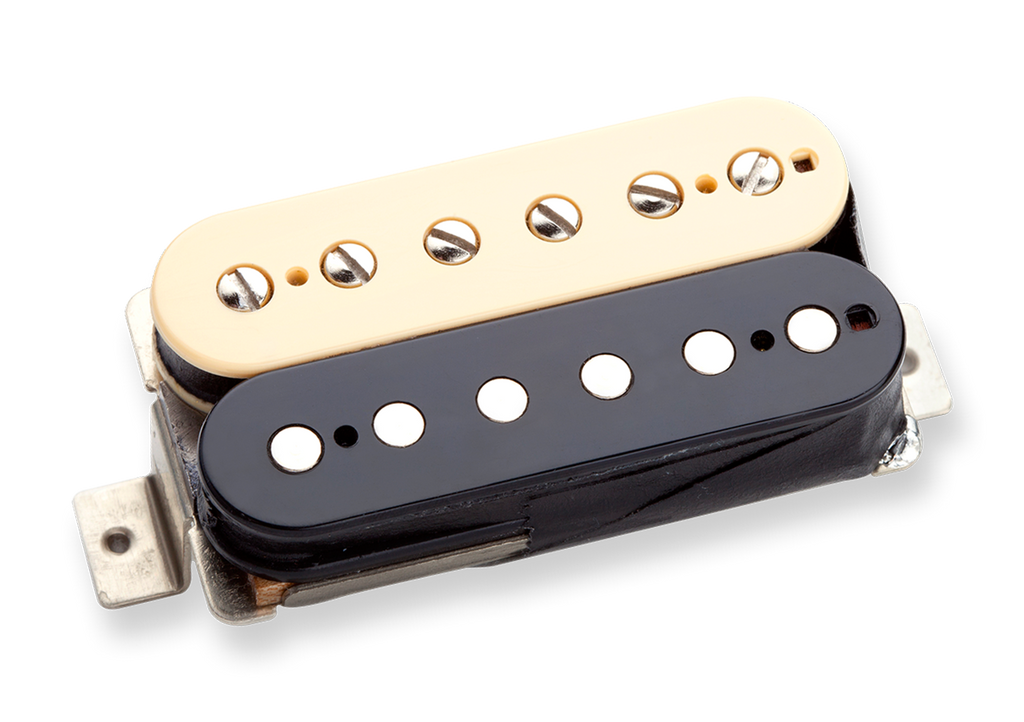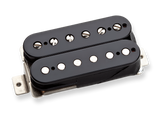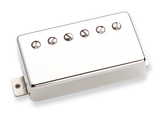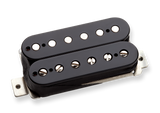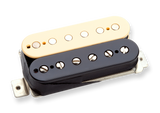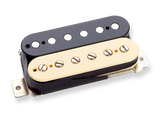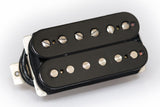From the manufacturer:
"
Summary: Neck
The 59 Model neck pickup is a warm, versatile humbucker with a big PAF sound that is great for playing both big, rich chords and fat sounding leads.
Description: Neck
While these vintage style coils give the 59 neck pickup an airy quality that keeps it planted firmly in the PAF family, the alnico 5 bar magnet, and vacuum wax potting have been added to accommodate lighter guitar strings and louder amplifiers than were ever used in the 50s. The result is a pickup with tons of old-school tonal character, but with a brighter top end, scooped mids, and a more compressed sound. Pair with the 59 bridge model for a traditional balance and sound, or pair with a higher output bridge model like the JB or Duncan Custom for a more aggressive setup.In addition to the alnico 5 magnet and wax potting, we hand build the 59 Model with a variety of traditional vintage treatments, such as 42AWG plain enamel mag wire, long legged nickel silver bottom plate, vintage single conductor braided push back lead wire, and no logo. As with all of our PAF style pickups, the 59 Model is wound on Seymours old Leesona winder from the early Gibson factory in Kalamazoo, MI.
Summary: Bridge
The 59 Model bridge pickup is a full sounding, versatile PAF style humbucker with an articulate treble attack, full bottom end, and scooped midrange.
Description: Bridge
The 59 bridge model is great for all types of rock and blues. We designed these vintage style coils to give it an airy quality that keep this pickup planted firmly in the PAF family. The alnico 5 bar magnet, and vacuum wax potting have been added to compensate for lighter guitar strings and louder amplifiers than were ever used in the 50s. The result is a pickup with tons of old-school tonal character, but with a brighter top end, and a more compressed sound. Pair with the 59 neck model for an evenly balanced output and tone.In addition to the alnico 5 magnet and wax potting, we hand build the 59 Model with a variety of traditional vintage treatments, such as 42AWG plain enamel mag wire, long legged nickel silver bottom plate, vintage single conductor braided push back lead wire, and no logo. As with all of our PAF style pickups, the 59 Model is wound on Seymours old Leesona winder from the early Gibson factory in Kalamazoo, MI.
"
Best videos/sound clips:
Here we have the extremely versatile and killer sounding Seymour Duncan '59 SH-1 pickup. This clip kicks off with clean tone demonstration of the neck pickup, showing just how round and clear they sound. At 0:58 we can hear how the neck pickup loves to naturally break up for a warm blues tone with a subtle saturation. The raw guitar tone comparison at 1:38 proves just how quiet and clear these pickups really are given their natural bite. Screaming rock tones can be heard at 1:53, boasting the endless sustain and bell-like sounds characteristic to the '59 SH-1. Lead metal tones can also be easily achieved as evidenced by the shredding leads at 2:28. These pickups will cut through any mix with its harmonic lead tone. A back-to-back clean comparison of the SH-1 neck pickup against other Seymour Duncan pickups begins at 3:10, during which you will notice how distinct the pickup is in terms of its frequency response and natural punch.
The player is Darius Wave and he is playing a Mayones Setius GTM 6 guitar through a Marshall JCM 2000 head, a Cornford Roadhouse 50 head, an Orange Rockerverb head, and a Peavey 5150 II head. He is mainly using a 2x12 cab by David Laboga.
This demo further reinforces the dynamic tone of the SH-1 -- from sustained cleans to a warm saturated blues tone. At 1:50 we can really hear how transparent the clean chords sound, yet they never manage to sound too shrill and harsh, and have zero issue cutting through the mix with sheer prescence.
The player is Geoff Waldron and he is playing a Hamer 2006 or 2007 Studio Custom.
This clip showcases the '59 SH-1 bridge pickup in its true element. With even just a little bit of overdrive the pickup screams at 0:13, producing a classic high-output sound that ranges from Texas blues to classic rock to even metal tones. The pickup responds so naturally to high gain, making it a fantastic choice for heavy rockers who want to rip sustained leads or play thick punchy power chords without getting muddied up. At 1:20 we can briefly hear the clarity and attack of the clean bridge tone before it fully explodes into the Eddie Van Halen style overdrive that this pickup does best.
The player is Geoff Waldron and he is playing a Hammer 2006 or 2007 Studio Custom.
Here we have a neck pickup comparison between the SH1-59' and the Blackout AHB-1 pickups, both by Seymour Duncan. Beginning with the SH-1-59', it's easy to notice the crystalline clean tone, with its clear attack and high-end sparkle. The Blackout is flatter in comparison, as we can hear a noticeable roll-off on the high end at 0:25. The SH1-59' sounds more responsive and has a distinct presence compared to the Blackout. At 0:40, we can really hear how the SH1-59' shines in the upper frequency range, producing bell-like tones that are extremely articulate and balanced. One thing that is consistent between both pickups is how quiet they are, resulting in a very clear natural tone. High-gain lead tones are demonstrated at the 2:00 mark, when we can hear how well the SH1-59'cuts with great bite and sustain. The Blackout at 2:10 is relatively comparable in sound, although it is a little more tame on the high-end and quieter overall, yet still a little less responsive than the SH1- 59'. At 2:20 we can hear the deep low-end of the SH-1, ideal for heavy riffing with great definition and clarity. The Blackout in comparison at 2:32 is slightly more active and really shines in a high-gain setting. Its lack of noise allows lower notes to sound extremely articulate and punchy. You can hear the true grit of the SH1-59' at 3:03, compared to the more saturated sounding Blackout at 3:13. Metal players are likely to prefer the Blackout for its low noise and articulate riffing capabilities; however, the SH1-59' has a more traditional frequency response and a very versatile tonal pallet.
The player is Mike Stamper and he is using a Washburn WI65c (with SH1-59') and a Washburn WI45 (with Blackouts).
This is a great demonstration the SH1-59' neck pickup being used in a metal context. Jump to 1:19 to hear its soaring lead tone and how easily it cuts through a mix of heavily distorted metal riffing. Each individual note has so much clarity and definition from the pickup that they never get lost in the huge wall of sound. The tone itself is smooth and bell-like with a focus in the mid to high range (without sounding too tinny) and a punchy low end that adds just the right amount of girth to the sound. Skip to 2:02 and you can hear how the SH1-59' interacts with the TB-6 in a clean tone setting, producing a glassy clean tone with smooth sustain and subtle attack.
The player is Shinodax Alfred and he is playing what appears to be a Carvin CT624 through an Axe-Fx II with a Shiva clean amp running into 2x12 black cab. For effects, he is using parallel wiring into a "medium plate" reverb and a "2290" delay set to 1/4 tempo.

